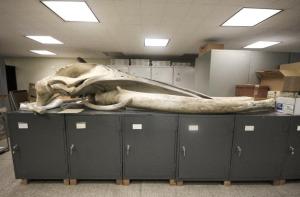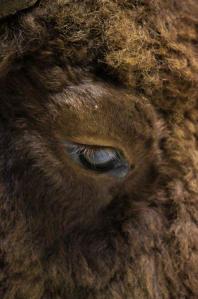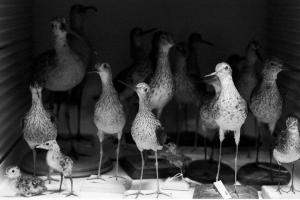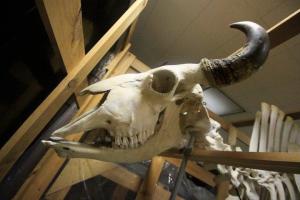This is a guest post written by Mari Provencher with photos from Mari Provencher Photography:

As I wander the special collections department of the New York State Museum, I wonder how I’ll explain myself if anyone asks what I’m doing here. The few souls that have wandered through seem unperturbed by the clicking of my camera’s shutter, loud as it is in this cavernous room. The metal cabinets that line every wall and create a labyrinth in its center do little to muffle the sound. No one seems to mind. I’m getting no complaints from the beaver skeletons or taxidermied water buffalo, so I keep going.
 By all rights, I think to myself, carefully sliding the skeleton of a a red fox towards me, so that its skull properly catches the light, I’m one of the more qualified people to be in here, outside of an actual scientist. My mom’s been working in natural history museums for as long as I can remember, so as a child I cultivated a special kind of awe for those animals that live on after their deaths by letting us study and catalogue them. And I never lost that awe. Today, here at the New York State Museum, I touched a blue whale skull. And all I could think was, “HOW COOL IS THIS?!??!” At some point, that skull was surrounded by flesh. It was thousands of leagues under the ocean, for years and years as the whale matured. It streamed krill. It fought other whales, and sharks, and who knows? Maybe even a giant squid. And somehow, through a myriad of twists and turns and happenstance, that skull and I crossed paths. I may never see it again, but for just one moment, I got to touch something majestic. I got to become a tiny part of its legacy. I also took a photo of it, and I can share that with the world. And in that way, I can help it live on just a little bit longer in the minds of everyone who sees that photo. Not bad for a Tuesday morning.
By all rights, I think to myself, carefully sliding the skeleton of a a red fox towards me, so that its skull properly catches the light, I’m one of the more qualified people to be in here, outside of an actual scientist. My mom’s been working in natural history museums for as long as I can remember, so as a child I cultivated a special kind of awe for those animals that live on after their deaths by letting us study and catalogue them. And I never lost that awe. Today, here at the New York State Museum, I touched a blue whale skull. And all I could think was, “HOW COOL IS THIS?!??!” At some point, that skull was surrounded by flesh. It was thousands of leagues under the ocean, for years and years as the whale matured. It streamed krill. It fought other whales, and sharks, and who knows? Maybe even a giant squid. And somehow, through a myriad of twists and turns and happenstance, that skull and I crossed paths. I may never see it again, but for just one moment, I got to touch something majestic. I got to become a tiny part of its legacy. I also took a photo of it, and I can share that with the world. And in that way, I can help it live on just a little bit longer in the minds of everyone who sees that photo. Not bad for a Tuesday morning.
 As I meander through another corridor, I find a label I don’t recognize. I twist the handle – quietly – and and open it up to find – to my delight – BIRDS! Taxidermied birds, some on perches, some with tags wrapped around their legs, all crammed carefully into place so as not to waste space. Beady glass eyes of every color stare back at me. They range in size from tiny hummingbirds to lyra birds with their huge tailfeathers. I open the next cabinet to find it stocked full of seagulls. After that, owls and falcons. I even come across a tiny case of baby birds in a nest, necks craned and beaks wide open, begging for food for all eternity. Little do they know that now, their biggest problem is becoming food – for all the tiny, nearly invisible bugs that infuriate every natural history museum.
As I meander through another corridor, I find a label I don’t recognize. I twist the handle – quietly – and and open it up to find – to my delight – BIRDS! Taxidermied birds, some on perches, some with tags wrapped around their legs, all crammed carefully into place so as not to waste space. Beady glass eyes of every color stare back at me. They range in size from tiny hummingbirds to lyra birds with their huge tailfeathers. I open the next cabinet to find it stocked full of seagulls. After that, owls and falcons. I even come across a tiny case of baby birds in a nest, necks craned and beaks wide open, begging for food for all eternity. Little do they know that now, their biggest problem is becoming food – for all the tiny, nearly invisible bugs that infuriate every natural history museum.
 Ah, dermestids! They may be every museum’s arch nemesis, but that tiny destructive force is indirectly responsible for one of my favorite childhood scents. I think of it as ‘The Smell of Science’, but really, it’s a combination of formaldehyde, moth balls, and all the other unidentifiable chemicals that are used to keep collections intact. You might not see anything appetizing about fifty-five year old taxidermied mountain lion, but to dermestid beetles that’s a feast. Even in my mother’s insect collection at home we have to put in tiny boxes of poison to keep the live bugs at bay. That’s just how nature is.
Ah, dermestids! They may be every museum’s arch nemesis, but that tiny destructive force is indirectly responsible for one of my favorite childhood scents. I think of it as ‘The Smell of Science’, but really, it’s a combination of formaldehyde, moth balls, and all the other unidentifiable chemicals that are used to keep collections intact. You might not see anything appetizing about fifty-five year old taxidermied mountain lion, but to dermestid beetles that’s a feast. Even in my mother’s insect collection at home we have to put in tiny boxes of poison to keep the live bugs at bay. That’s just how nature is.
This cool, silent storage facility has my heart pounding. Exploring it is like a grand scavenger hunt, where every door you open leads to something fascinating in its own right. Not for the first time, I think to myself, why can’t everyone learn like this? High school biology was fun and all, but textbooks don’t give me this kind of rush. (Bill Bryson addresses this problem in his book ‘A Brief History of Nearly Everything’, which I highly recommend.) Why doesn’t everyone get to experience this feeling of togetherness with the world? Sitting among these dusty relics, everything makes so much sense. Humans fit right in here. We may be the ones scurrying away among the stacks, cataloging, organizing, and categorizing, but it’s not in a condescending way. These creatures are all lovingly researched by people who understand their importance and want to give them a legacy. Just as each of us strives for meaning in our own individual lives, so too do the taxidermists and skeletal reconstructionists wish for these animals. When we learn from them, we give them a place in our own history.
So please, I beg you, I implore you, the next time you find yourself at a museum, the next time you find a bone in the woods or a shell on the beach, stop and think of the journeys that brought you both together. Right now, in this moment, you are a part of the world and of history and of a great, big, wild universe.
And how unbelievably cool is that?!